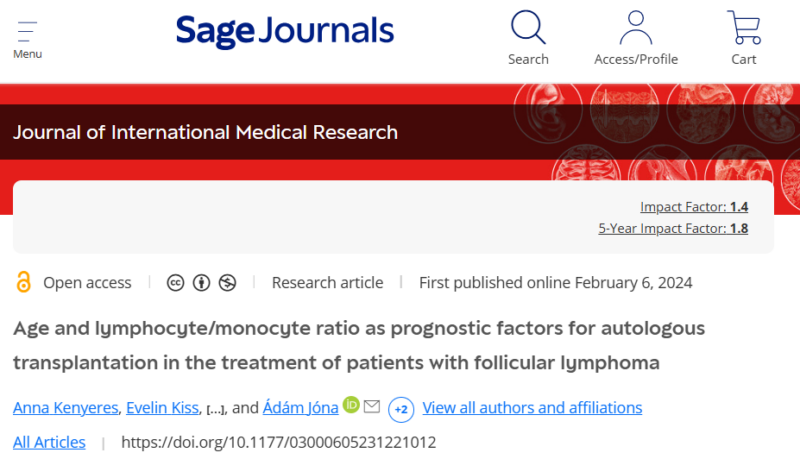Authors: Anna Kenyeres, Evelin Kiss, Zsófia Simon, Árpád Illés, Ádám Jóna

Published in Journal of International Medical Research, on February 6, 2024
Introduction
Follicular lymphoma (FL) remains one of the most common indolent lymphomas, with treatment approaches continuously evolving. While overall survival (OS) has improved significantly over the past two decades, reaching beyond 20 years in some cases, questions persist about the role of autologous stem cell transplantation (ASCT) in treatment strategies. This study investigated prognostic factors and outcomes in patients with FL undergoing ASCT, with particular attention to age and blood cell ratios.
Design/Methods
The authors conducted a retrospective analysis of 49 patients with FL who underwent ASCT between 2004 and 2021 at the Department of Hematology, University of Debrecen. The median age of patients was 48 years (range, 28-65). The study examined multiple potential prognostic factors, including:
- Age and disease grade
- Pre-transplant disease status
- Lymphocyte/monocyte (Ly/Mo) ratios
- Treatment timing and response
- PET/CT imaging results
- FLIPI scores
- Bone marrow involvement
Most patients (75%) received transplants after their first chemosensitive relapse, with 38 patients showing progression of disease within 24 months of initial treatment (POD24). The majority received anti-CD20-BEAM conditioning regimen, and over half achieved complete remission before transplantation.
What We Learned
The study revealed several key findings with median follow-up of 37 months (range, 1-196 months):
Survival Metrics
- Median progression-free survival (PFS): 48 months post-transplant
- OS: median not reached
- A total of 9 patients achieved “functional cure” with PFS of >98 months
Prognostic Factors
- Age and Ly/Mo ratio independently affected PFS (p=0.017 and p=0.008, respectively)
- Age alone influenced OS (p=0.021; HR=1.079; 95% CI: 1.012-1.151)
- ROC analysis identified critical thresholds:
- Age: 47 years
- Lymphocyte/monocyte ratio: 2.675
Combined Risk Factors
- Patients >47 years old with Ly/Mo ratio ≥2.675 showed significantly worse outcomes (p=0.0200)
- Patients with FL and POD24 demonstrated inferior PFS post-transplant
- Disease status (complete vs. partial remission) before transplant did not impact outcomes
Key Takeaway Messages
- Age >47 years combined with Ly/Mo ratio ≥2.675 identifies a high-risk patient population (p=0.0019), providing a simple, cost-effective screening tool for transplant candidacy assessment.
- POD24 significantly impacts post-transplant PFS without affecting OS, suggesting successful salvage options exist for post-transplant relapses.
- Achievement of PFS >98 months in 9 patients demonstrates ASCT’s potential for durable remissions in selected patients with FL.
- Pre-transplant disease status (complete vs. partial remission) does not significantly impact outcomes, indicating ASCT benefits may extend to a broader patient population than previously considered.
- Regular monitoring of Ly/Mo ratio combined with age stratification could improve patient selection for ASCT, potentially sparing high-risk patients from less effective interventions and directing them toward alternative therapeutic approaches earlier.
This study adds valuable insights to the growing body of knowledge about ASCT in FL treatment. While limited by its retrospective nature and sample size, it identifies practical prognostic markers that could help clinicians make more informed treatment decisions. The findings suggest that age and lymphocyte/monocyte ratio could serve as simple yet effective tools for risk stratification in patients with FL considering ASCT.
The research aligns with previous studies while offering new perspectives on risk stratification, particularly through the combined use of age and Ly/Mo ratio as prognostic indicators. These findings could help optimise patient selection for ASCT and identify those who might benefit more from alternative treatment strategies.
Find More “Paper Alerts” on OncoDaily.
